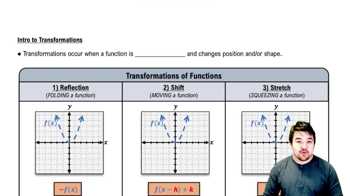Table of contents
- 0. Functions7h 52m
- Introduction to Functions16m
- Piecewise Functions10m
- Properties of Functions9m
- Common Functions1h 8m
- Transformations5m
- Combining Functions27m
- Exponent rules32m
- Exponential Functions28m
- Logarithmic Functions24m
- Properties of Logarithms34m
- Exponential & Logarithmic Equations35m
- Introduction to Trigonometric Functions38m
- Graphs of Trigonometric Functions44m
- Trigonometric Identities47m
- Inverse Trigonometric Functions48m
- 1. Limits and Continuity2h 2m
- 2. Intro to Derivatives1h 33m
- 3. Techniques of Differentiation3h 18m
- 4. Applications of Derivatives2h 38m
- 5. Graphical Applications of Derivatives6h 2m
- 6. Derivatives of Inverse, Exponential, & Logarithmic Functions2h 37m
- 7. Antiderivatives & Indefinite Integrals1h 26m
- 8. Definite Integrals4h 44m
- 9. Graphical Applications of Integrals2h 27m
- 10. Physics Applications of Integrals 2h 22m
4. Applications of Derivatives
Differentials
Problem 4.R.116a
Textbook Question
Cosine limits Let n be a positive integer. Evaluate the following limits.
lim_x→0 (1 - cos xⁿ) / x²ⁿ
 Verified step by step guidance
Verified step by step guidance1
Recognize that the limit involves an indeterminate form 0/0 as x approaches 0, which suggests the use of L'Hôpital's Rule or a series expansion.
Consider using the Taylor series expansion for cos(x) around x = 0: cos(x) ≈ 1 - x²/2 + x⁴/24 - ... . For cos(xⁿ), substitute xⁿ into the series: cos(xⁿ) ≈ 1 - (xⁿ)²/2 + (xⁿ)⁴/24 - ... .
Substitute the series expansion into the limit expression: (1 - (1 - (xⁿ)²/2 + ...)) / x²ⁿ = ((xⁿ)²/2 - ...) / x²ⁿ.
Simplify the expression: ((x²ⁿ)/2 - ...) / x²ⁿ = (1/2) - ... . As x approaches 0, higher order terms become negligible.
Conclude that the limit evaluates to 1/2 as x approaches 0, since the dominant term in the expansion is (1/2).
 Verified video answer for a similar problem:
Verified video answer for a similar problem:This video solution was recommended by our tutors as helpful for the problem above
Video duration:
5mPlay a video:
Was this helpful?
Key Concepts
Here are the essential concepts you must grasp in order to answer the question correctly.
Limit of a Function
In calculus, the limit of a function describes the behavior of that function as its input approaches a certain value. It is a fundamental concept used to define continuity, derivatives, and integrals. Evaluating limits often involves techniques such as substitution, factoring, or applying L'Hôpital's rule when dealing with indeterminate forms.
Recommended video:

Limits of Rational Functions: Denominator = 0
Taylor Series Expansion
The Taylor series expansion is a representation of a function as an infinite sum of terms calculated from the values of its derivatives at a single point. For the cosine function, the expansion around zero is given by cos(x) = 1 - x²/2! + x⁴/4! - ... This series is useful for approximating functions and simplifying the evaluation of limits, especially when dealing with small values of x.
Recommended video:

Intro to Transformations
L'Hôpital's Rule
L'Hôpital's Rule is a method for evaluating limits of indeterminate forms, such as 0/0 or ∞/∞. It states that if the limit of f(x)/g(x) results in an indeterminate form, the limit can be found by taking the derivative of the numerator and the derivative of the denominator separately. This rule is particularly helpful in simplifying complex limit problems, such as the one presented in the question.
Recommended video:
Guided course

Power Rules







